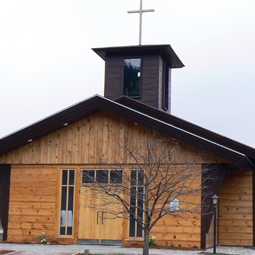John Paul II Eucharistic Center Dedicated in Hanceville, Ala.
Cardinal Burke Presided at Mass
HANCEVILLE, Ala. — Dec. 8 marked another major milestone at the Shrine of the Most Blessed Sacrament and Our Lady of the Angels Monastery with the dedication of the new John Paul II Eucharistic Center.
The dedication ceremonies began with a noon Mass in the shrine’s main chapel, celebrated by Cardinal Raymond Burke and televised on EWTN. A non-Eucharistic procession followed to the center for the dedication.
Cardinal Burke, prefect of the Supreme Tribunal of the Apostolic Signatura, told the Register before the dedication that he envisions the center "will serve both as an introduction for pilgrims to the great richness of the encounter with our Eucharistic Lord at the Shrine of the Most Blessed Sacrament in Hanceville and as a means to continue reflecting on the great gift of the encounter with our Eucharistic Lord."
The center’s design includes what appear to be altar railings lining the front, and behind them, there is a large image of John Paul II holding aloft a monstrance as if to bless visitors.
"The purpose of the Eucharistic Center is to educate pilgrims who visit the shrine, where the central focus is the Blessed Sacrament, on the meaning and history of the real presence of Our Lord," explained Sister Mary Jacinta of the Poor Clares of Perpetual Adoration, founded in 1854 and brought to Hanceville by Mother Angelica, the foundress of EWTN.
"Many of the pilgrims who come are not Catholic," she said, "and through the Eucharistic Center, they will be able to understand the reason for the shrine and the meaning of the perpetual adoration that takes place here."
Franciscan Father Joseph Wolfe, EWTN chaplain, called the center the brainchild of the Sisters of Perpetual Adoration. The idea grew from the outdoor Stations of the Eucharist that the Poor Clares had already created.
"Both the Stations of the Holy Eucharist and the John Paul II Eucharistic Center are really for the education of those who do not know the Catholic faith or do not understand the Catholic faith, to help them understand the gift of the Eucharist," noted Father Wolfe.
A large percentage of the visitors to the shrine are not Catholic, Father Wolfe said. Frequently, bus groups from local colleges come to see what a European church or 13th-century art would be like. Now, they can also find answers to spiritual questions. But the center is most certainly Catholic.
Father Wolfe explained: "There are many Catholics who do not fully appreciate the treasure of the holy Eucharist. [The center will] help them have a greater understanding and appreciation of the Eucharist as well."
Multimedia displays include a representation of the Passover meal that foreshadows the Eucharist and a feature that takes visitors to the Last Supper. Short videos explain each area.
"The sets depicting typical first-century Jewish life give a dynamic backdrop to the words of Scripture, in which Christ explained and gave the holy Eucharist," said Sister Mary Jacinta, calling the displays one highlight among many.
Large paintings that are reproductions of Old Masters’ works add more insights, like Caravaggio’s Descent From the Cross.
Sister Mary Jacinta explained that they help to strikingly convey the fact that the Mass is the representation of Calvary and depict the words of St. Paul in 1 Corinthians 10:16-17: "The cup of blessing that we bless, is it not a participation in the blood of Christ? The bread that we break, is it not a participation in the body of Christ? Because the loaf of bread is one, we, though many, are one body, for we all partake of the one loaf."
Another highlight she pointed out are several interactive computer stations, where visitors can select frequently asked questions about the Eucharist and have them answered in video presentations.
"Non-Catholics will have the freedom to explore their own questions about the Eucharist and find the answers," she said.
Father Wolfe noted that visitors will understand the connection that the Mass has with both the Old and New Testaments, in addition to the Church’s 2,000-year deposit of faith.
Among the center’s many features, he cites the list where Eucharistic miracles have taken place to depictions of saints with special connections to the Eucharist. Among them are St. Thomas Aquinas, who wrote the Eucharistic hymns Tantum Ergo and O Salutaris Hostia that Catholics still use today; St. Imelda, patroness of girl first communicants; and St. Tarcisius, patron of boy first communicants, who died a martyr protecting the Blessed Sacrament. There is also a triumphant Lamb of God statue.
Also, an interactive area specifically for children helps young Catholics learn more about the Eucharist.
The choice of naming the center after John Paul II was easy, Sister Mary Jacinta said.
"His deep love for Our Lord’s Eucharistic presence, so evident in his life, his priesthood, his writings — notably his encyclical Ecclesia de Eucharistia, as well as his proclamation of the Year of the Eucharist — has led many people to encounter Our Lord and to rediscover this great mystery," she explained.
"The Holy Father understood the importance of true culture," she added. "The Eucharistic Center highlights the culture that has flourished from the Church’s Eucharistic life. Blessed John Paul II is a fitting patron for such a center."
- Keywords:
- Dec. 15-28, 2013
















